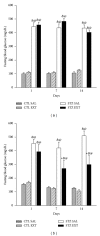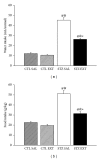Myrcia bella Leaf Extract Presents Hypoglycemic Activity via PI3k/Akt Insulin Signaling Pathway
- PMID: 24872834
- PMCID: PMC4020406
- DOI: 10.1155/2014/543606
Myrcia bella Leaf Extract Presents Hypoglycemic Activity via PI3k/Akt Insulin Signaling Pathway
Abstract
Species of Myrcia are used by indigenous people and in traditional communities in Brazil for the treatment of Diabetes mellitus. We investigated the hypoglycemic effect of the extract of leaves of Myrcia bella in diabetic mice. The chemical fingerprinting of the 70% EtOH extract characterized as main constituents flavonoid aglycones, flavonoid-O-glycosides, and acylated flavonoid-O-glycosides derivatives of quercetin and myricetin. Mice were treated with saline or extract of M. bella (300 or 600 mg/Kg b.w.) for 14 days. Body weight and water and food intake were measured every day. Fasting blood glucose was measured weekly. At the end of the treatment, blood insulin, triglycerides, total cholesterol, and protein were measured. Glycogen content and expression of proteins of the insulin signaling pathway were measured in liver. The treatment with 600 mg/Kg reduced the fasting blood glucose in diabetic mice of the 7th day as water and food intake and increased hepatic glycogen. Total cholesterol and triglycerides were reduced in diabetic treated mice. The treatment increased the expression of IRS-1, PI3-K, and AKT in the livers of diabetic treated mice. The results indicate that the extract of the leaves of Myrcia bella has hypoglycemic properties and possibly acts to regulate glucose uptake by the liver.
Figures







References
-
- Sociedade Brasileira de Diabetes (SBD) Diretrizes da Sociedade Brasileira de Diabetes, 2009, http://www.diabetes.org.br/attachments/diretrizes09_final.pdf.
-
- Grover JK, Yadav S, Vats V. Medicinal plants of India with anti-diabetic potential. Journal of Ethnopharmacology. 2002;81(1):81–100. - PubMed
-
- Kumar A, Ilavarasan R, Jayachandra T, et al. Anti-diabetic activity of Syzygium cumini and its isolated compound against streptozotocin-induced diabetic rats. Journal of Medicinal Plants Research. 2008;2(9):246–249.
LinkOut - more resources
Full Text Sources
Other Literature Sources

